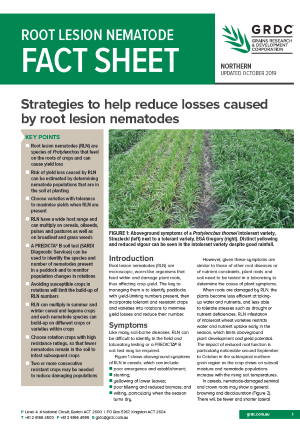Root Lesion Nematode - Northern
Root Lesion Nematode - Northern
Published: 1 Oct 2019
Root lesion nematodes (RLN) are microscopic, worm-like organisms that feed within and damage plant roots, thus affecting crop yield. The key to managing them is to identify paddocks with yield-limiting numbers present, then incorporate tolerant and resistant crops and varieties into rotations to minimise yield losses and reduce their number.
Key Points
- Root lesion nematodes (RLN) are species of Pratylenchus that feed on the roots of crops and can cause yield loss
- Risk of yield loss caused by RLN can be estimated by determining nematode populations that are in the soil at planting
- Choose varieties with tolerance to maximise yields when RLN are present
- RLN have a wide host range and can multiply on cereals, oilseeds, pulses and pastures as well as on broadleaf and grass weeds
- A PREDICTA® B soil test (SARDI Diagnostic Services) can be used to identify the species and number of nematodes present in a paddock and to monitor population changes in rotations
- Avoiding susceptible crops in rotations will limit the build-up of RLN numbers
- RLN can multiply in summer and winter cereal and legume crops and each nematode species can build-up on different crops or varieties within crops
- Choose rotation crops with high resistance ratings, so that fewer nematodes remain in the soil to infest subsequent crops
- Two or more consecutive resistant crops may be needed to reduce damaging populations.
Download PDF
Region: North
GRDC Project Code: DAV1703-012RMX,

